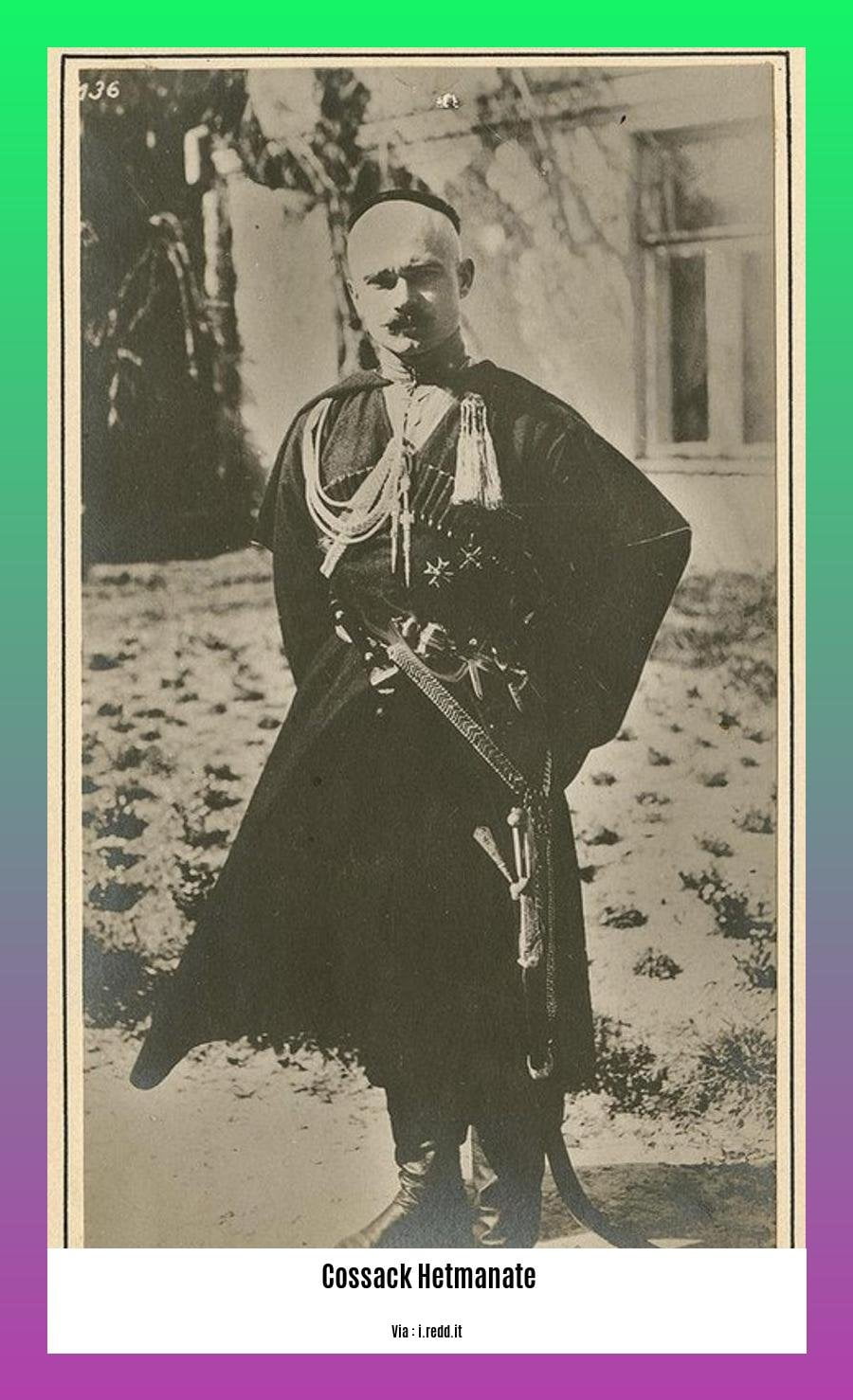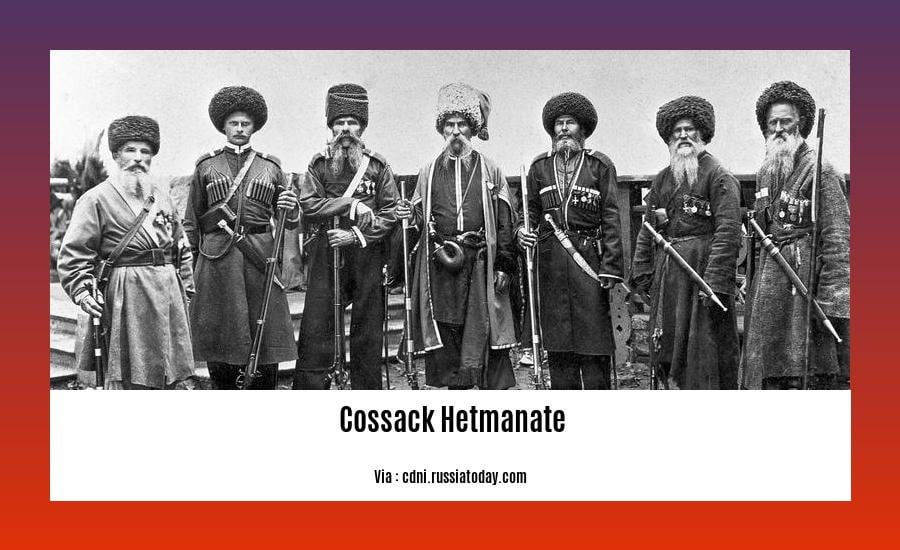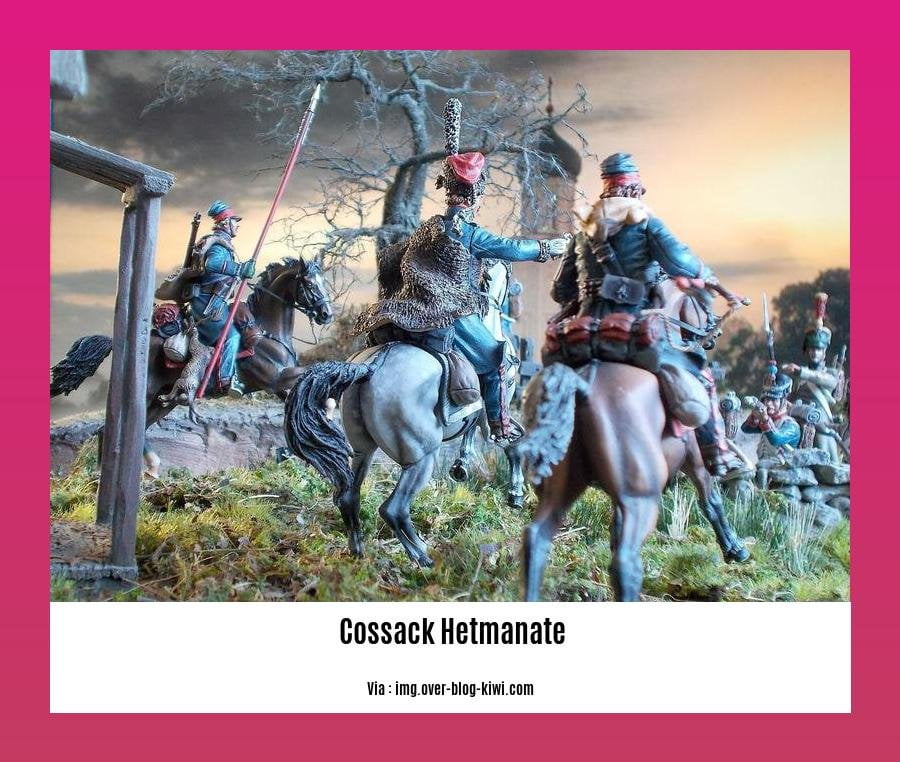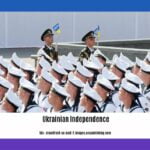Embark on a riveting historical expedition with “The Cossack Hetmanate: A Comprehensive Exploration of Its History and Significance.” This article delves into the captivating saga of the Cossack Hetmanate, an autonomous polity that played a pivotal role in shaping Eastern Europe’s destiny.
Key Takeaways:
- The Cossack Hetmanate was a Ukrainian Cossack state established in central Ukraine.
- It existed from 1648 to 1764 and was also known as the Zaporizhian Host or Army of Zaporizhia.
- The Hetmanate was governed by a Hetman who held broad powers.
- Its society experienced cultural flourishing, particularly under Hetman Ivan Mazepa, and was divided into five groups: nobility, Cossacks, clergy, townspeople, and serfs.
- The state’s history was marked by successful military campaigns led by Hetman Bohdan Khmelnytsky against the Poles.
- The Hetmanate’s supreme power rested with the General Cossack Council.
Cossack Hetmanate

The Cossack Hetmanate was a Ukrainian Cossack state that existed from 1648 to 1764, also known as the Zaporizhian Host or Army of Zaporizhia. Its cultural flourishing, particularly under Hetman Ivan Mazepa, and its agrarian-feudal economy characterized the Hetmanate.
Governance and History
Established after successful military campaigns against the Poles led by Hetman Bohdan Khmelnytsky, the Cossack Hetmanate was ruled by a Hetman with broad powers, including supreme military commander and executive leader. The state’s supreme power belonged to the General Cossack Council.
Culture and Society
Society was divided into five groups: nobility, Cossacks, clergy, townspeople, and serfs. The cultural flourishing of the Hetmanate included notable figures like Mazepa and a rich Cossack tradition.
Notable Hetmans:
| Hetman | Reign | Significance |
|---|---|---|
| Bohdan Khmelnytsky | 1648-1657 | Led the successful campaigns against Poland |
| Ivan Mazepa | 1687-1709 | Promoted cultural and educational reforms |
| Ivan Skoropadsky | 1708-1722 | Allied with Russia against Sweden |
To better understand the intricate past of this captivating country, delve into our comprehensive account of the History of Ukraine.
Discover the origins and legacy of Kievan Rus, the formidable medieval state that laid the foundation for Ukrainian identity by clicking Kievan Rus.
Witness the triumph of Ukrainian independence through our in-depth exploration, accessible at Ukrainian Independence.
Social and Economic Life within the Hetmanate

The Cossack Hetmanate was a dynamic and evolving society with a unique social and economic structure. Here’s a closer glimpse:
Social Hierarchy:
- Nobility: A small minority of landowners with significant wealth and influence.
- Cossacks: The backbone of Hetmanate society, serving as warriors and farmers.
- Clergy: The Orthodox Church played a crucial role in social and cultural life.
- Townspeople: Merchants, artisans, and craftsmen resided in growing towns and cities.
- Peasants: Serfs and free rural workers formed the majority of the population.
Economic Activities:
Agriculture: The Hetmanate’s economy was primarily agrarian, with a focus on grain production.
Trade: Flourished along major rivers and trade routes connecting the Hetmanate to other regions.
Industry: Small-scale industries developed in urban areas, including ironworking, leatherworking, and brewing.
Economic Challenges:
- Landownership disputes: Nobility and Cossacks often fought over land rights.
- Periodic invasions: The Hetmanate faced frequent incursions from neighboring powers like Poland, Russia, and the Crimean Khanate.
- Serfdom: Serfs worked on noble estates under harsh conditions, contributing to social tensions.
Key Takeaways:
- Social hierarchy: The Cossack Hetmanate had a complex social structure with various classes playing distinct roles.
- Economic activities: Agriculture was the mainstay, while trade and industry also contributed to the economy.
- Economic challenges: Landownership disputes, invasions, and serfdom hindered economic growth.
Citations:
- Cossack Hetmanate – Wikipedia
- Bohdan Khmelnytsky – Encyclopedia of Ukraine
Relationship with Neighbouring Powers
The Cossack Hetmanate, established in the mid-17th century, found itself at a crossroads of powerful neighbours: the Russian Empire, the Polish-Lithuanian Commonwealth, and the Ottoman Empire. These relationships with neighbouring powers were crucial in shaping the Hetmanate’s political and territorial development.
Russia
The Treaty of Pereiaslav (1654) established a vassal relationship between the Hetmanate and Russia. While providing protection from Polish attacks, this alliance came at a cost of increasing Russian influence and limitations on Cossack autonomy.
Poland-Lithuania
The Polish-Lithuanian Commonwealth had long sought to regain control over the Cossack lands lost during the Khmelnytsky Uprising. However, repeated attempts to subdue the Hetmanate through military campaigns proved unsuccessful.
Ottoman Empire
The Ottoman Empire, with its vast territories bordering the Hetmanate, maintained a complex relationship marked by both conflict and cooperation. While supporting Cossack uprisings against Poland, the Ottomans also sought to limit Cossack expansion into Ottoman territories.
Key Takeaways:
- The Hetmanate’s location at the crossroads of powerful neighbours shaped its political destiny.
- The alliance with Russia brought protection but also limited Cossack autonomy.
- Poland-Lithuania’s attempts to regain control over the Cossack lands were unsuccessful.
- The Ottoman Empire played a complex role, supporting Cossack uprisings while also limiting their expansion.
Sources:
- The Cossack Hetmanate
- Treaty of Pereiaslav
Legacy and Impact of the Cossack Hetmanate
The Cossack Hetmanate, an independent Ukrainian state that existed from 1649 to 1764, played a pivotal role in shaping Eastern European history. Its legacy continues to resonate today, leaving an enduring impact on the region’s culture, politics, and traditions.
Cultural Heritage
The Hetmanate fostered a vibrant cultural environment, producing renowned figures such as the Baroque architect Ivan Mazepa. Cossack songs and dances became integral parts of Ukrainian folklore, while the Hetmanate’s unique architecture and art influenced the development of Ukrainian national style.
Political Legacy
The Hetmanate established an independent Ukrainian state, challenging the dominance of Poland and the Russian Empire. Its military prowess and diplomatic skills contributed to the emergence of modern Ukraine and its struggle for sovereignty.
Socio-economic Impact
The Hetmanate’s social structure reflected the diversity of its population. Cossacks, nobles, clergy, townspeople, and serfs coexisted, influenced by both Western and Eastern traditions. The Hetmanate’s economy, based on agriculture and trade, laid the foundation for Ukraine’s economic development.
Key Takeaways:
- Cultural Legacy: Fostered Ukrainian folklore, art, and architecture.
- Political Significance: Established an independent Ukrainian state, challenging foreign powers.
- Socio-economic Impact: Contributed to Ukraine’s social and economic development, reflecting diverse cultural traditions.
Citations:
- Encyclopedia of Ukraine: Hetmanate
- Wikipedia: Cossack Hetmanate
FAQ
Q1: When was the Cossack Hetmanate established?
A1: The Cossack Hetmanate was established in 1649, after the successful military campaigns against the Poles led by Hetman Bohdan Khmelnytsky.
Q2: What was the official name of the Cossack Hetmanate?
A2: The official name of the Cossack Hetmanate was the Zaporozhian Host or Army of Zaporizhia.
Q3: How was the Cossack Hetmanate governed?
A3: The Cossack Hetmanate was governed by a Hetman and the General Cossack (Military) Council. The Hetman was the head of state and supreme military commander, while the General Cossack Council was the state supreme power.
Q4: What was the economy of the Cossack Hetmanate like?
A4: The Cossack Hetmanate had an agrarian-feudal economy, with some industrial development. Agriculture was the primary economic activity, and the main crops were wheat, rye, and barley.
Q5: What was the social structure of the Cossack Hetmanate?
A5: The social structure of the Cossack Hetmanate was divided into five groups: nobility, Cossacks, clergy, townspeople, and serfs. The Cossacks were the dominant social group, and they enjoyed special privileges and exemptions from taxes.
- Unveiling the Enigma: Mansoureh Khojasteh Bagherzadeh’s Public Appearances & Private Life in Iran - July 18, 2025
- Unveiling the Mystery: Mansoureh Khojasteh Bagherzadeh’s Husband: A Rare Glimpse into a Private Life - July 18, 2025
- Unveiling Masoud Khamenei’s Mother: Power, Influence, and Iran’s Future - July 18, 2025
















